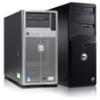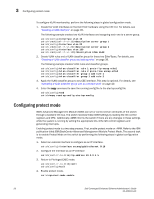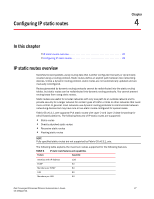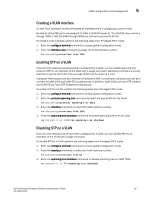Dell PowerEdge M520 Dell Converged Enhanced Ethernet Administrator's Guide - Page 49
Configuring VLANs Using the CEE CLI, In this VLAN overview, Ingress VLAN filtering,
 |
View all Dell PowerEdge M520 manuals
Add to My Manuals
Save this manual to your list of manuals |
Page 49 highlights
Chapter Configuring VLANs Using the CEE CLI 5 In this chapter •VLAN overview 31 •Ingress VLAN filtering 31 •VLAN configuration guidelines and restrictions 33 •Default VLAN configuration 33 •VLAN configuration and management 34 •Configuring protocol-based VLAN classifier rules 38 •Configuring the MAC address table 40 VLAN overview IEEE 802.1Q Virtual LANs (VLANs) provide the capability to overlay the physical network with multiple virtual networks. VLANs allow you to isolate network traffic between virtual networks and reduce the size of administrative and broadcast domains. A VLAN contains end stations that have a common set of requirements that are independent of physical location. You can group end stations in a VLAN even if they are not physically located in the same LAN segment. VLANs are typically associated with IP subnetworks and all the end stations in a particular IP subnet belong to the same VLAN. Traffic between VLANs must be routed. VLAN membership is configurable on a per interface basis. The VLAN used for carrying FCoE traffic needs to be explicitly designated as the FCoE VLAN. FCoE VLANs are configured through the CEE CLI (see "Configuring a VLAN interface to forward FCoE traffic" on page 36). NOTE Currently only one VLAN can be configured as the FCoE VLAN. Ingress VLAN filtering A frame arriving at Dell FCoE hardware is either associated with a specific port or with a VLAN, depending on whether the frame is tagged or untagged: • Admit tagged frames only-The port the frame came in on is assigned to a single VLAN or to multiple VLANs depending on the VLAN ID in the frame's VLAN tag. This is called trunk mode. • Admit untagged frames only-These frames are assigned the port VLAN ID (PVID) assigned to the port the frame came in on. This is called access mode. Dell Converged Enhanced Ethernet Administrator's Guide 31 53-1002116-01















